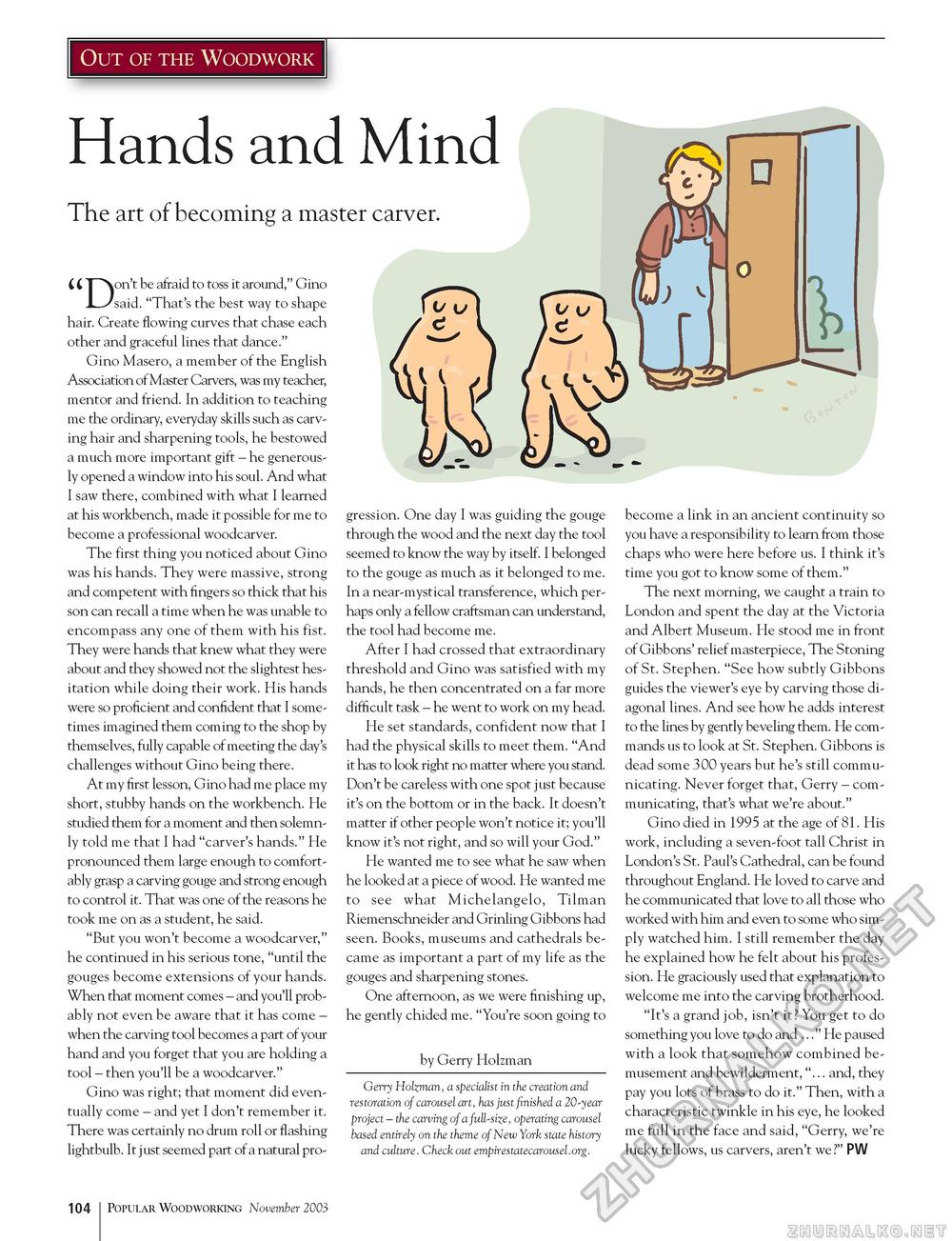Popular Woodworking 2003-11 № 137, страница 105
Hands and Mind The art of becoming a master carver Out of the Woodwork ( ( T~^\on't be afraid to toss it around," Gino 1__'said. "That's the best way to shape hair. Create flowing curves that chase each other and graceful lines that dance." Gino Masero, a member of the English Association of Master Carvers, was my teacher, mentor and friend. In addition to teaching me the ordinary, everyday skills such as carving hair and sharpening tools, he bestowed a much more important gift - he generously opened a window into his soul. And what I saw there, combined with what I learned at his workbench, made it possible for me to become a professional woodcarver. The first thing you noticed about Gino was his hands. They were massive, strong and competent with fingers so thick that his son can recall a time when he was unable to encompass any one of them with his fist. They were hands that knew what they were about and they showed not the slightest hesitation while doing their work. His hands were so proficient and confident that I sometimes imagined them coming to the shop by themselves, fully capable of meeting the day's challenges without Gino being there. At my first lesson, Gino had me place my short, stubby hands on the workbench. He studied them for a moment and then solemnly told me that I had "carver's hands." He pronounced them large enough to comfortably grasp a carving gouge and strong enough to control it. That was one of the reasons he took me on as a student, he said. "But you won't become a woodcarver," he continued in his serious tone, "until the gouges become extensions of your hands. When that moment comes - and you'll probably not even be aware that it has come -when the carving tool becomes a part of your hand and you forget that you are holding a tool - then you'll be a woodcarver." Gino was right; that moment did eventually come - and yet I don't remember it. There was certainly no drum roll or flashing lightbulb. It just seemed part of a natural pro gression. One day I was guiding the gouge through the wood and the next day the tool seemed to know the way by itself. I belonged to the gouge as much as it belonged to me. In a near-mystical transference, which perhaps only a fellow craftsman can understand, the tool had become me. After I had crossed that extraordinary threshold and Gino was satisfied with my hands, he then concentrated on a far more difficult task - he went to work on my head. He set standards, confident now that I had the physical skills to meet them. "And it has to look right no matter where you stand. Don't be careless with one spot just because it's on the bottom or in the back. It doesn't matter if other people won't notice it; you'll know it's not right, and so will your God." He wanted me to see what he saw when he looked at a piece of wood. He wanted me to see what Michelangelo, Tilman Riemenschneider and Grinling Gibbons had seen. Books, museums and cathedrals became as important a part of my life as the gouges and sharpening stones. One afternoon, as we were finishing up, he gently chided me. "You're soon going to by Gerry Holzman Gerry Holzman, a specialist in the creation and restoration of carousel art, has just finished a 20-year project - the carving of a full-size, operating carousel based entirely on the theme of New York state history and culture. Check out empirestatecarousel.org. become a link in an ancient continuity so you have a responsibility to learn from those chaps who were here before us. I think it's time you got to know some of them." The next morning, we caught a train to London and spent the day at the Victoria and Albert Museum. He stood me in front of Gibbons' relief masterpiece, The Stoning of St. Stephen. "See how subtly Gibbons guides the viewer's eye by carving those diagonal lines. And see how he adds interest to the lines by gently beveling them. He commands us to look at St. Stephen. Gibbons is dead some 300 years but he's still communicating. Never forget that, Gerry - communicating, that's what we're about." Gino died in 1995 at the age of 81. His work, including a seven-foot tall Christ in London's St. Paul's Cathedral, can be found throughout England. He loved to carve and he communicated that love to all those who worked with him and even to some who simply watched him. I still remember the day he explained how he felt about his profession. He graciously used that explanation to welcome me into the carving brotherhood. "It's a grand job, isn't it? You get to do something you love to do and ..." He paused with a look that somehow combined be-musement and bewilderment, ". and, they pay you lots of brass to do it." Then, with a characteristic twinkle in his eye, he looked me full in the face and said, "Gerry, we're lucky fellows, us carvers, aren't we?" PW 104 Popular Woodworking November 2003 |







